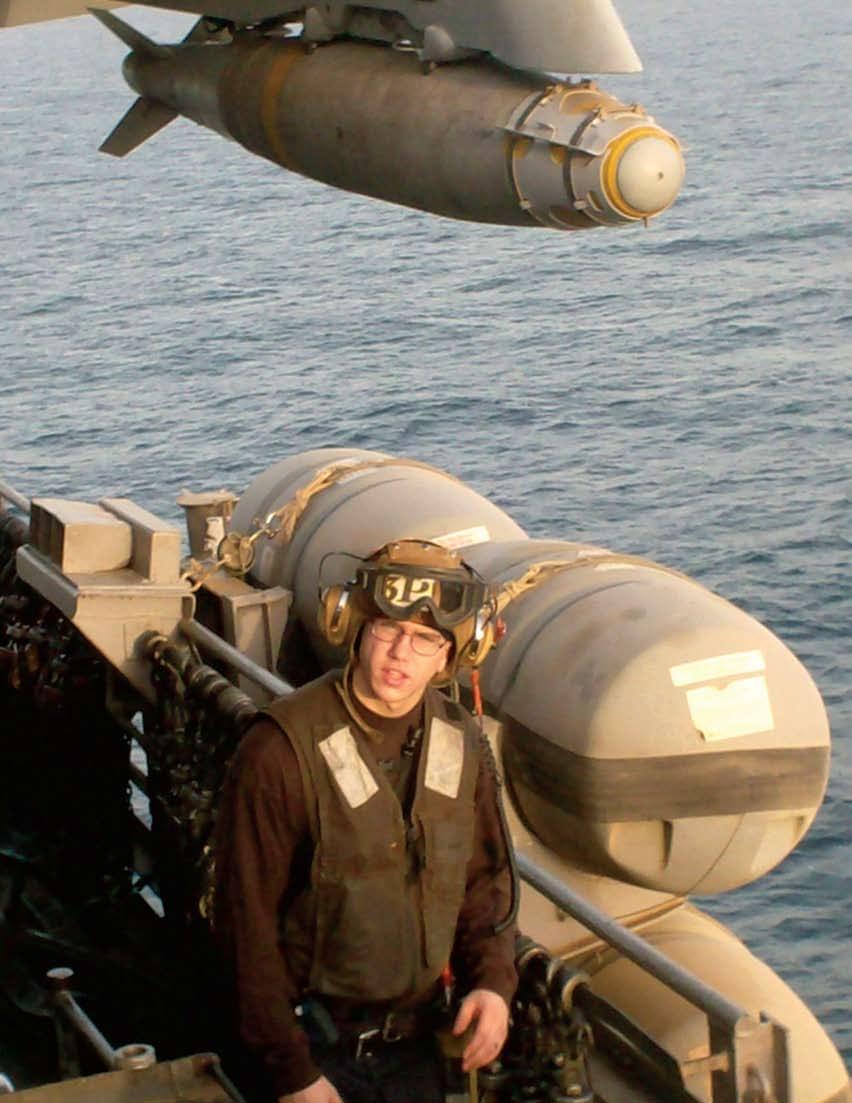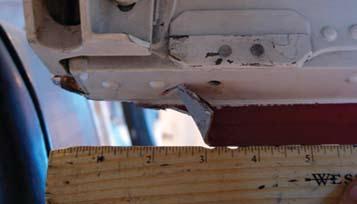
23 minute read
What I Learned at Mast
from MECH Fall 2008
By AT3 Jacqueline Bufkin I Damaged propeller from the boom crashing down on it. recently had checked into the squadron and was looking forward to proving my skills to my new command. However, barely two months into my tour, I incurred an Article 92 violation of the UCMJ. I damaged an aircraft nose-landing-gear door, while operating a tow tractor (A/S32A-42) without a valid support equipment (SE) license. My only thought at the time was, “Where did I go wrong?”
A series of errors, starting in my previous command, had led to this situation. SE licenses are valid for three years, but the program requires all operators NLG and tractor (above), NLG close up (below) of self-propelled support equipment to possess a state driver’s license. My previous command had limited the expiration date on my tow-tractor license, based on the expiration of my state driver’s license. When I renewed my state license, I got preoccupied with back-to-back Cables were also destroyed. detachments and my impending transfer, and I never requalified for my support-equipment license.
Advertisement
I completed FRS training and was sent to TPU because my new command was deployed. TPU sent me back TAD to my original command, but when I tried to renew my SE license, the AMO told me I couldn’t because I no longer was permanently assigned.
I transferred to my fleet squadron a month later cart. Suddenly, I heard a cracking sound, and my spotter and asked the beach-det supervisor about renewing yelled, “Stop!” my support-equipment qualifications. He said that the It was too late. I had hit the bottom inch of the transfer of my quals would be easy, and my SE license nose-landing-gear door. I shut off the tractor and notistill was valid because I had arrived from another VFA fied my supervisor and QA. The landing-gear door had command. I didn’t point out that, even though my Phase to be repaired, and the tow tractor was damaged slightly. II paperwork indicated I had a valid qualification, my SE Everyone initially thought my license was current, license actually had expired, as indicated on my yellow including the QAR from GSE. They mistakenly had tow-tractor license. When my squadron returned stateassumed I had a current license after reviewing my side, my LPO said my quals would be transferred after Phase II paperwork and my current state driver’s license. the post-deployment leave period. However, I went to CO’s mast.
During that leave period, a petty officer filling in for Had I taken a proficiency exam, as required by the my LPO tasked me to move an A/M32A-108 power cart command to renew my qualifications, I would have next to aircraft 410 in the hangar. I wanted to get the job learned several things. First, a chief is required to overdone and never thought about the consequences of drivsee any towing operations within the hangar bay or in ing with an expired SE license. Using a spotter, I towed close proximity to an aircraft. I also would have learned the power cart next to the aircraft, within the safety that power carts are pushed by hand inside the hangar, diamond. My spotter detached the tow bar, but there not towed close to the aircraft. If I had renewed my SE was not enough room to turn the tractor around. He license, had received proper supervision, and had pracpushed the power cart back, while I tried to drive the ticed ORM, this incident could have been avoided. tractor between the nose of the aircraft and the power Petty Officer Bufkin works in the AT shop at VFA-131.
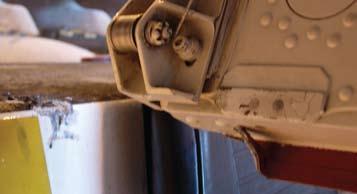
Send BZs to: SAFE-Mech@navy.mil
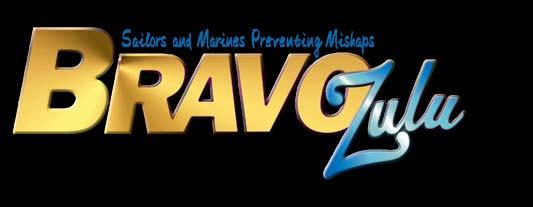

BZ Quarter of the
AD2 Eric Bagho VFA-15
During a low-power turn, pre-operational inspection, Petty Officer Bagho noticed the starboard engine on an FA-18C was not seated on the airframe. He saw what looked like an abnormal gap between the variable exhaust nozzle and the exhaust-fairing assembly, or turkey feathers. Further investigation revealed the engine’s outboard thrust mount, one of the three attachment points that affix each engine to the airframe, had failed. This problem likely would have resulted in catastrophic engine failure. Petty Officer Bagho’s actions exemplify the importance of doing thorough visual inspections.
As much as we use computers and digitized sensors to diagnose problems with our aircraft, a sharp pair of eyeballs is often the best tool. Later the same day, Petty Officer Bagho was spot-awarded the Navy Achievement Medal by VFA-15’s commanding officer.
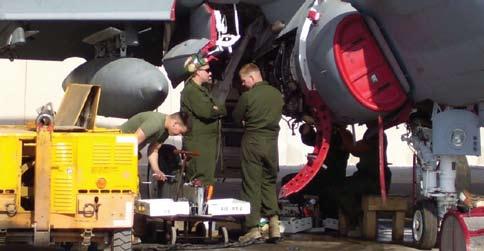
down-and-locked indication when it was time to land, and the nose of the aircraft could have hit the runway upon landing.
Airman Juarez immediately reported the discrepancy to the maintenance-control supervisor. For his attention to detail, Airman Juarez was awarded the Navy and Marine Corps Achievement Medal. He also was named Lancer Safety Pro of the Month.
Cpl. J.T. Gamblin and Sgt. T.H. Thiesen VMAQ-4
While directing the night launch of an EA-6B, Cpl. Gamblin saw fuel leaking from the starboard-engine bay door. He found that the source of the leak was the fuel-control bleed line. He quickly alerted the pilot and had him secure the engine. The aircrew then manned up the back-up jet and successfully launched on a combat mission. Meanwhile, plane captain Gamblin and Sgt. Thiesen, a CDQAR for power plants, determined that the fuel line had been lying on the combustion chamber, causing the inner tube of the line to melt.
Further investigation revealed that, after installation of the bearing chip collector, the bleed line had been rerouted from its original position in order to reach the fuel control. Gamblin and Thiesen downed the aircraft, fixed the discrepancy, and prevented a recurrence by training their mechs.
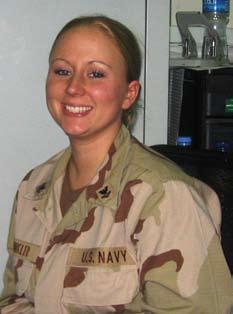
AM3 Robert Shultz HSL-37 Det. 2
During a crew swap of ER-50 aboard USS Reuben James (FFG-57), Petty Officer Shultz noticed a large amount of hydraulic fluid under the tail pylon. He immediately removed a panel from the starboard side of the pylon and found a pinhole leak on the pressure line for the No.1 tail-rotor servo. This leak would have caused an in-flight emergency.
AN Zachary Juarez VAQ-131
During a turnaround inspection on Skybolt 500, Airman Juarez found that the retract actuator for the noselanding gear was disconnected. As a result, the nose-landing gear could not have been retracted once airborne. If the aircrew had taken off, the landing gear would have stayed in a trail position throughout the flight. The aircrew wouldn’t have been able to get a safe,
AZ2 Neeley Hunkler VP-26
Even though they work “behind the scenes” in the maintenance department, aviation maintenance administrationmen (AZs) sometimes save the day and prevent mishaps. Petty Officer Hunkler of Patrol Squadron 26 showed good attention to detail and persistence on three occasions during an ISIS inspection for P-3 aircraft BUNO 161412. First, she found the No. 3 generator serial number did not match the ISIS paperwork. The component had been replaced more than 12 months earlier, but the necessary paperwork hadn’t made it into the logbook. Also, during 161412’s combined acceptance/ISIS inspection, she found the No. 4 prop serial number had been documented incorrectly in the aeronautical equipment-service record (AESR) for the past five years. Finally, the No. 3 turbine rotor’s serial number was incorrect.

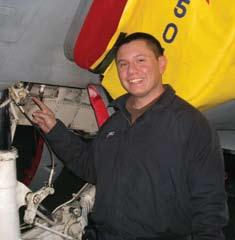
Apparently, two turbine rotors were built up and installed on two different engines at the same time. Hunkler contacted the repository for carded items, which showed that the component on aircraft 161412 was in Whidbey Island. The repository contacted that squadron for a serial-number check of their aircraft. The serial number for VP-26’s turbine was found on the Whidbey Island squadron’s aircraft.
The initiative demonstrated by Petty Officer Hunkler prevented three critical, time-consuming component changes.
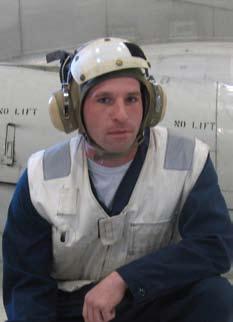
AM2 Jota Molina HSL-45
While troubleshooting the aircraft track-and-balancing system on a main rotor head, Petty Officer Molina noticed that the “Z” bracket appeared to be installed wrong. He realized that the nuts securing the bolts to the “Z” bracket were missing. His meticulous scrutiny and subsequent actions corrected this potentially serious problem.
AD1 Robert Davis HS-6
Petty Officer Davis, a CDQAR, was overseeing the servicing of the intermediate gearbox on Indian 610. He noticed the oil from the servicing unit was discolored. He immediately stopped the servicing and discovered the servicing unit was contaminated with water from a recent storm. After notifying the maintenance-control chief of the situation, he drained and flushed the gearbox and downed the servicing unit. His action prompted an inspection of all command servicing units; it also prompted wingwide notification.
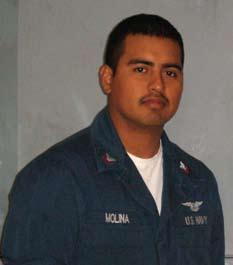
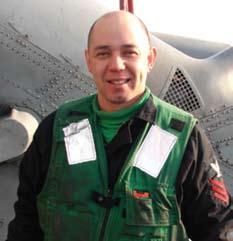
AM2 Kevin Gaboy VP-30
Petty Officer Gaboy was “diving” the No. 3 fuel tank of LL513 as a final QA check before signing off the MAF and closing the fuel cell. He expanded on the “18-inch rule” and inspected the entire fuel cell. Petty Officer Gaboy found an acid brush immediately forward of the No. 3 surge box, near the low-point drain (approximately six feet from the work area). If he only had followed procedures to the letter of the law, the fuel cell would’ve been closed up with the acid brush still inside. The worst-case scenario could have resulted in the acid brush eventually lodging within the booster feed line for the No. 3 engine, possibly causing an engine flame out.
AM2 Justin Lucas HSL-45 Det. 2
While securing aircraft 52 after a functional-check flight, Petty Officer Lucas spotted a small amount of hydraulic-fluid residue on the port side of the SH-60B. Further investigation revealed a pinhole on the APU-accumulator return line. This discrepancy could have resulted in catastrophic failure of the No. 3 hydraulic system. Petty Officer Lucas notified QA personnel and downed the aircraft.
AW2 Kevin McIsaac HSL-45
During a routine hot-seat shutdown to fix a popped corner-fastener, Petty Officer McIsaac found a subtle imperfection on the underside of one main rotor blade. Further inspection revealed that an object had hit the blade, causing significant damage and calling into question its flight worthiness. Petty Officer McIsaac downed the aircraft.
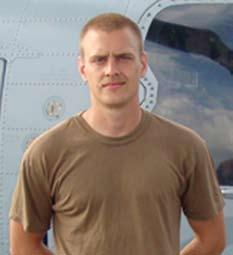
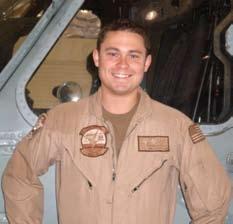
AD2 Weng Chau HSL-45 Det. 2
During a routine aircraft refueling, Petty Officer Chau noticed a fuel hose beginning to swell near the fuel nozzle. He immediately secured refueling procedures. Further inspection revealed a degraded hose that no longer was serviceable.
Petty Officer Chau notified the appropriate quality-assurance personnel, and immediate action was taken to avert a potential fuel leak and possible fire on board USS Vandegrift (FFG-48).
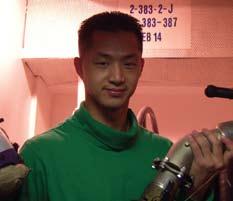
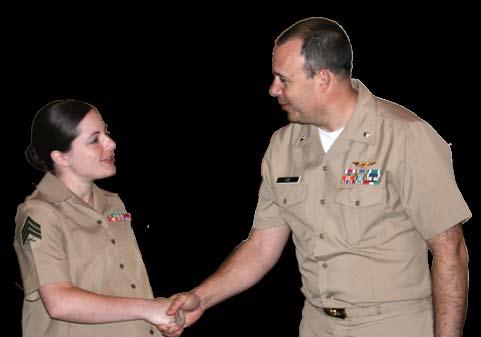
The ninth annual fleet maintainers’ conference was held in April 2008. PMA202 (aircrew systems) recognized Navy and Marine Corps maintainers in the fields of aviation life support, egress, oxygen, and night-vision systems.
The Douglas L. Scott Memorial Maintainer of the Year Award (AME maintainer) recognizes superior performance and support in the field of egress systems and aircraft-mounted oxygen systems. The award winner was AME1(AW) Christopher E. Green, VFA-41. The other two finalists were AME1(AW) Richard D. Brickey, VFA-2; and AME1(AW/SW) Jeremy A. Moncier, VAQ-133.
The Robert J. Hudson Maintainer of the Year Award (PR/FE maintainer) recognizes superior performance and support in the field of aviation lifesupport systems. The award winner was Sgt. Frances O. White, MALS-31. The other two finalists were PR1(AW) Jamison J. Krein, HSL-49; and PR1(AW) Anthony V. Slavas, VR-54.
The Richard P. James Memorial Maintainer of the Year Award (NVS maintainer) recognizes superior performance and support in the field of night-vision systems. The award winner was Cpl. Kenneth A. Griewahn, MALS-39. The other two finalists were AE2 Nathan W. Ducharme, FRC MA Oceana; and PR3 Tamara L. Whitmer, HS-6.
Congratulations to all nominees and award winners!
AD2 Sehn Phu HSL-43
During a daily inspection on Battlecat 30, Petty Officer Phu discovered a bushing on the forward-bridgeretaining zee bracket was not seated fully and had begun to work loose. Inspection showed the loose bushing had created a hairline crack in the zee bracket. If left undetected, the loose bushing and crack could have created an extremely hazardous situation, affecting the helicopter’s flight-control system. Petty Officer Phu assisted with the successful repair of the bridge assembly.
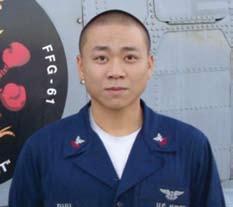
Sgt. Frances White, MALS-31
Cpl. Kenneth Griewahn, MALS-39
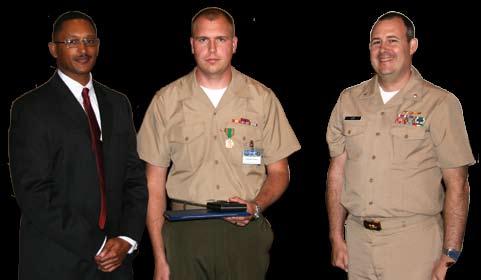
crossfeed
Maintenance Officer
Cdr. Bert Ortiz bert.ortiz@navy.mil
Editorial Coordinator
ADCS(AW) Michael Tate michael.tate@navy.mil
I’ll Meet You Over There
By AMCS(AW) James Litviak
It started out as a typical cold, rainy and foggy February morning. Our squadron was scheduled to transfer Bear Ace 603 to PMI-1, which was located in a hangar on the opposite side of the runway. The aircraft had been gutted, including the removal of most panels and both engines, and we were scheduled to deliver it no later than noon. Its delivery date already had slid one day because of a modification that had been done the day before. All we had to do was physically transfer the aircraft. Besides supervising the desk that morning, I had been put in charge of getting the aircraft to PMI-1. I recognized the job required crossing the runway, and a transient-line escort was required to coordinate with the tower. At 0845, I called the transient line and requested a follow-me truck for a 1000 escort to cross the runway. Their response was, “Chief, we can’t do it at 1000 because we have another job at 0930, but we can do it right now.”
I thought for a few seconds, and said “It’s a bit earlier then expected, and I still have to wrap up some loose ends. But OK, I’ll get the move crew together in a hurry, give them a quick brief, and we’ll get it done.”
Moving aircraft is a daily evolution for a squadron, so this job would take no time at all. We towed the aircraft out of the hangar, and as expected, the follow-me truck was waiting for us outside. I knew the T-line had a deadline too, so my brief was short. I pointed at the hangar across the runway and barked to the plane captain and wing walkers, “Follow this driver over to that hangar, and I’ll meet you over there.”
Off they went. Recognizing it would be a while
Photo submitted by: AM1 (AW/SW David Karlson, VAW-124 Safety Petty Officern
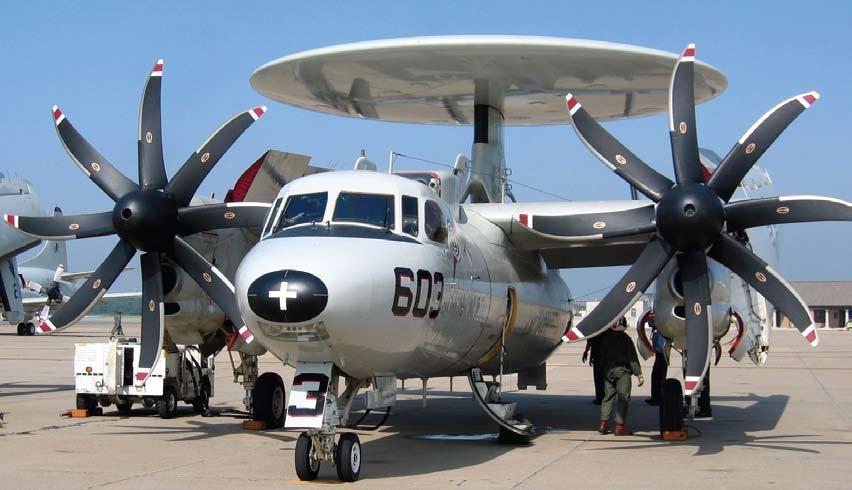
before they arrived at the PMI-1 hangar, and that I surely would beat them there, I went to tie up the loose ends associated with transferring the aircraft. Here’s where my plan began to unravel. As I entered maintenance control, a barrage of questions came in my direction. An aircrew inquired, “Is 602 ready to fly?” An airman asked, “Chief, how do I get a GSE class?” My quick five minutes of tying up loose ends turned into 10 to 15 minutes. Realizing the time, I finished what I was doing, grabbed the logbooks, hopped in my car, and drove down the perimeter road to the PMI hangar.
As soon as I got there, the PMI manager met me with a handful of my crew. I scanned the area and imme
Navy photo by MC3 Kristopher Wilson
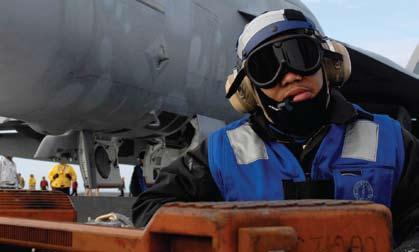
diately recognized I was missing one or two people. I asked the plane captain, “Where’s the tractor driver?” He nonchalantly replied that he had sent him back because he didn’t need him anymore. Immediately, I flipped open my cellphone and called our maintenance control. An AZ answered. “Put the maintenance master chief on the phone right now,” I yelled. The MMCPO requested the immediate return of the T-line follow-me truck. However, I thought it might be too late. I just prayed that nothing catastrophic had occurred.
I had a nightmarish image of a COD taking off en route to a CVN off the coast, or worse, a “graceful” C-5 Galaxy taking off for, or landing after, a long, direct flight from Iraq, while my tractor driver was motoring across the runway. To make things worse, I knew the tractor driver would have his cranial on and goggles down, which might prevent him from hearing an aircraft as it rumbled down the runway toward him.
I was thankful none of the above scenarios occurred. However, as sure as the sun rises, the airman drove the tractor straight across the runway, with no follow-me truck in sight. Luckily, no aircraft were landing or taking off. When we notified the T-line about the runway incursion, they told us that the tower had not called them regarding the incident and probably had not even noticed.
I stood there with my plane captain in front of me, and I gave him that “do you have any last words” look. I emphatically demanded to know, “What part of ‘I’ll meet you guys over there’ did you not understand?” He gave me a shoulder shrug and replied that he didn’t know why, but he just wanted to get the tractor back as soon as possible. He thought the follow-me truck was required only when an aircraft was under tow.
With the knowledge that everybody was safe, I momentarily pondered his answer, and I began to kick myself. First and foremost, I was responsible for the safe execution of the move. While I had had the best of intentions, I had rushed the evolution because of the new time constraints. I had conducted a verbal brief on the move over to the PMI-1 hangar but had assumed they would not depart without my approval. I had only told them, “I’ll meet you over there,” because I had planned to address the return trip when we were all together in front of the PMI-1 hangar. I also had assumed the towtractor driver and the plane captain both understood the requirement for the follow-me truck.
With the best of intentions, I unwittingly had overlooked two of the principles of ORM. First, I had not anticipated and managed risk through planning. Second, I inadvertently had accepted unnecessary risk. ORM principles and processes help us preserve our Sailors and our assets. The repercussions of ignoring them could have been catastrophic.
With this in mind, I had options available to me that could have prevented what occurred. I could have emphasized that no one was to leave the PMI hangar until I had arrived. I also could have advised the T-Line that we weren’t prepared to move the aircraft earlier than originally scheduled. This would have allowed me to reschedule the move in the afternoon when they were available. Also, this would have allowed me to coordinate with the PMI-1 hangar for a later delivery time, and I would have had more time to fully brief the evolution and make sure that the move crew had no questions.
Before any major maintenance evolution, our squadron uses a major-maintenance-evolution checklist that incorporates ORM. We do not, however, use this checklist for daily tasks, such as moving aircraft. Instead, we rely on verbal briefs. As maintenance professionals, we should apply a form of our maintenance checklist to jobs that may seem routine. Minor differences introduce the possibility of uncertainty and potentially increase risk.
Senior Chief Litviak is a maintenance analyst at the Naval Safety Center.
Hazmat
Hazardous Material’s Unique Identifier
By AMCS(AW) James Litviak
Problem: Is your hazardous material uniquely identified for reference and retrieval? OPNAVINST 5100.23G states that your command is responsible for having a quick reference for retrieval.
My travels with the Naval Safety Center survey teams have shown that 90 percent of the commands didn’t have a quick reference incorporated with their hazmat program. Most commands had their MSDS in numerical order, as their AUL lists them. However, that’s only two-thirds of the way toward completing the unique identifier in this situation.
Solution: The hazardous material must have the same numbering system as the actual container. For example, if your AUL lists MIL-PRF-83282 hydraulic fluid as the first item, your MSDS must have a number “1” written on it. Additionally, it must be the first MSDS in your MSDS binder. The next step is to place a number “1” on each container of hydraulic fluid. Ask a shipmate if he or she can retrieve an MSDS for the hazmat you currently have checked out, and see how long it takes him or her to find it—if at all. Next, incorporate the unique identifier, and again ask that shipmate to get the MSDS for you. He or she will find it in 30 seconds or less.
Best Practicing commands: VAW-124, VRC-40, HSC-8.
Senior Chief Litviak is a maintenance analyst at the Naval Safety Center.
Logs and Records
NALCOMIS Errors Can Lead to a Mishap
By SSgt. David Jenkins-Jackson
Problem: Over the past year, I have noticed a common trend across the fleet with the Technical Directive/Logs and Records portion of the NALCOMIS OMA/ OOMA database. Statistical information in NALCOMIS does not always match the information in the aircraft logbook.
What happens, quite often, is that once an aircraft is received from a transferring organization, statistical errors are generated by a problem within NALCOMIS, or someone erroneously enters data from the logbook in the system. The knowledge of these errors is 1 of 3 factors that ultimately can lead to a mishap.
This issue continues to surface because of a lack of attention to detail in screening SRC data. The data include critical-fatigue-time for many aircraft components, and information about technical-directive compliance. The data should be verified before being uploaded into the system. Logs and Records/Maintenance Control must understand that time-sensitive items that are not properly tracked can lead to a mishap.
Solution: COMNAVFORINST 4790.2A, Chap 5, para. 5.2.1.2.1 and 5.2.1.2.11, shows that improper documentation, lack of communication, and inaccurate maintenance are the three, stand-alone causal factors in maintenance-related aviation mishaps. Logs and Records/Maintenance Control must pay close attention in screening documentation in order to verify, record, and maintain all maintenance information in the NALCOMIS database, as well as the logbook.
Overall, good communication and strict attention to detail are keys to mitigate NALCOMIS problems. Communication is the most essential tool for proper inventory, accurate maintenance practices, and accurate documentation.
Best Practice: VMX-22, from MCAS New River, has an excellent Logs and Records/TD program. They enforce a strict policy of verifying all safe-for-flight information, which includes the base-line of all component fatigue time, TD routing/compliance procedures, and documentation of active and historical data for all aeronautical equipment maintained in the NALCOMIS database as well as in the logbook.
Staff Sergeant Jenkins-Jackson is a maintenance analyst at the Naval Safety Center.
Quality Assurance
Those Follow-Up QA Audits
By AMCS(AW) Robert Chenard
Problem: Half of the squadrons surveyed in fiscal year 2008 had a weak audit follow-up process. This issue also was briefed by CNAF AMMT as one of their top 10 discrepancies. Squadrons didn’t follow up, let too much time pass, or took inadequate corrective actions.
Solution: CNAF 4790.2A, para. 10.7.3.2.c, states that the MO shall: “Ensure corrective action and QA follow-up on discrepant areas are performed within a reasonable time frame (normally 10 working days) and that the corrective action is adequate.”
Best Practice: The best practice is to treat QA audits like a MAF—with a discrepancy, a sign-off, and a QA in-process. Each discrepancy needs to be understood clearly. The corrective action (sign-off) should not only address the issue but the root cause of the problem, so it can be avoided in the future. The QA follow-up (in-process) should clearly state the condition found; “verified”, “corrected”, and other one-word answers are not adequate responses.
Commands already doing this include: VAW112, VMFA(AW)-242, VMFT-401, VR-55, VAQ-140 and VRC-30.
Senior Chief Chenard is a maintenance analyst at the Naval Safety Center.
Class C Mishap Summary
By ADCS(AW) Michael Tate
From June 9, 2008, to September 19, 2008, the Navy and Marine Corps had 22 Class C mishaps involving 22 aircraft.
During this quarter, a single incident caught my eye. It involved the accepted practice of using any available plastic to cap lines, or to seal openings on components to protect them from FOD. The mishap resulted from an uncontrolled consumable ending up where it did not belong: in a helicopter’s main transmission.
Night check, anticipating weekend liberty, had removed an input module from a gear box and sealed the opening with a plastic bag. The new module was installed later that night. Somewhere in the chain of events, the bag was sealed inside the gearbox. After the engines were shut down on an attempted FCF, a huge trouble-shooting event was initiated to fix an oil-pressure discrepancy.
After maintainers changed the oil-pressure switch and the aircrew returned to the bird, another engine turn was attempted. The problem remained, and further troubleshooting included changing the same pressure switch again, a drain and flush on the oil system, and replacement of two scavenge pumps. Ground turn number four was unsuccessful but also added a popped oil-pressure-differential indicator (PDI) to the equation. This indicated an oil problem in the gearbox and led to removal of the originally installed input module. Large amounts of plastic were found inside the gearbox, clogging the ports.
Adhering to NAMP tool-control procedures, which include accounting for all consumables, would have prevented this chain of events. These mechanics and technicians are true professionals, but it’s human nature to make mistakes sometimes. We always must enforce our procedures and review lessons learned to prevent mishaps. In many respects, the concept and everyday merging of ORM into our environments will help to eliminate this type of discrepancy. No one was injured in this incident, but many unnecessary parts were replaced, and a lot of man-hours were spent because of a plastic bag.
NAMP specifies to cover holes on the main gearbox if the input-module assembly does not need to be replaced immediately, but it does not specify a method to cover the holes. The NAVAIR Level I preservation guidelines direct the transmission and gearboxes to be sealed and all associated openings covered with a specific type and class of barrier paper and tape. However, a lot of maintenance personnel seem to be unfamiliar with the correct process for sealing the main-transmission gearbox after removing a transmission-module assembly.
Senior Chief Tate is a maintenance analyst at the Naval Safety Center and coordinator of the Crossfeed section of Mech. Mech
Sierra Helping Sailors and Marines Help Themselves Sierra H otel
Commander, Naval Safety Center would like to recognize the following aviation commands for their recent participation in safety surveys, culture workshops, and maintenance malpractice resource management (MRM) presentations for the months of June-September.
Safety Surveys VX-23 CMO-10 HSC-8 VX-20 VAQ-129 VX-1 TPS VQ-1 HX-21 VP-8 FRCW Fallon SFDW VPU-1 VR-62 VFA-37 VFA-106 VFA-211 MALS-39 VP-10 VAW-124 VMFAT-101 VRC-40 VAQ-140 HSC-21 VAQ-130 VP-40 VAQ-135 VQ-2 VFA-136 VMFA-314 MALS-11 HSC-3 HS-6

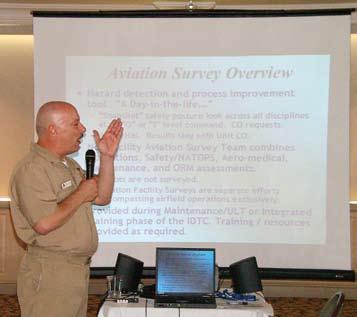

MRMs FRC: NAS Corpus Christi, TX MALS-12 and VMFA-212: MCAS Iwakuni, Japan AMO Course: NAS Pensacola, FL HSC-84: NS Norfolk, VA VR-56: NAS Oceana, VA VQ-3, VQ-4, VQ-7, and COMSTRATCOMWING ONE: Tinker AFB, OK VX-30 and VR-55: NAS Point Mugu, CA
Culture Workshops
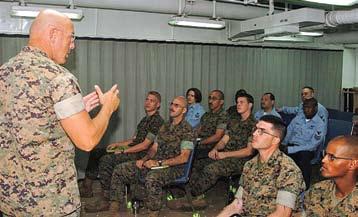
HMLA-775 HMLA-267 VMFA(AW)-121 HS-7 VFA-105 VFA-32 VFA-86 HSL-51 VFA-147 VAQ-135 VFA-41 VFA-204 VT-21 VT-22
Navy photo by MC1 Michael Kennedy
For more information or to get on the schedule, please contact: Safety Surveys: Maj. Anthony Frost, USMC at 757-444-3520 Ext. 7223, MRM: AMCS(AW) Robert Chenard at 757-444-3520 Ext. 7221, Culture Workshop: Cdr. Duke Dietz at 757-444-3520 Ext. 7212.
ORM can prevent crushing loads
